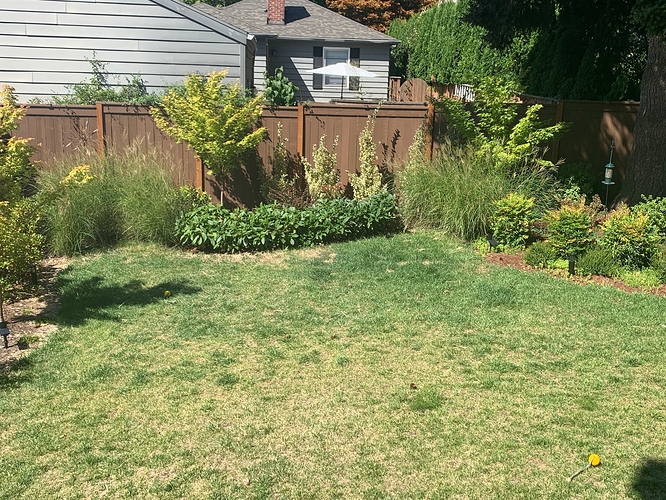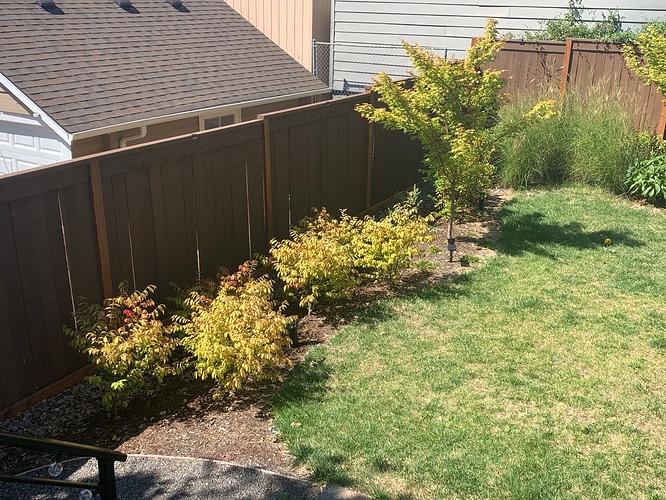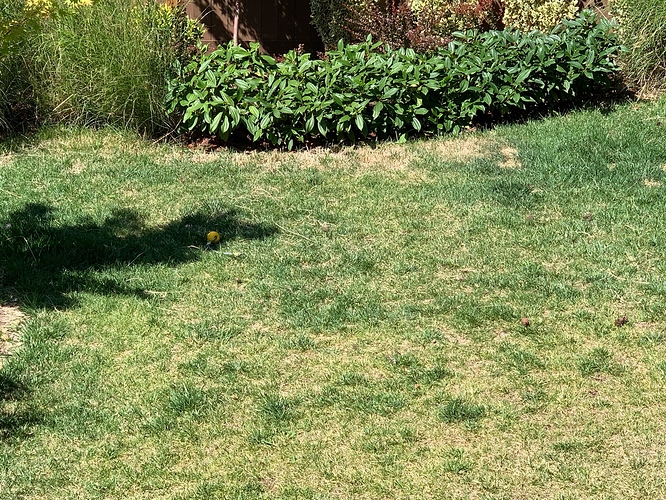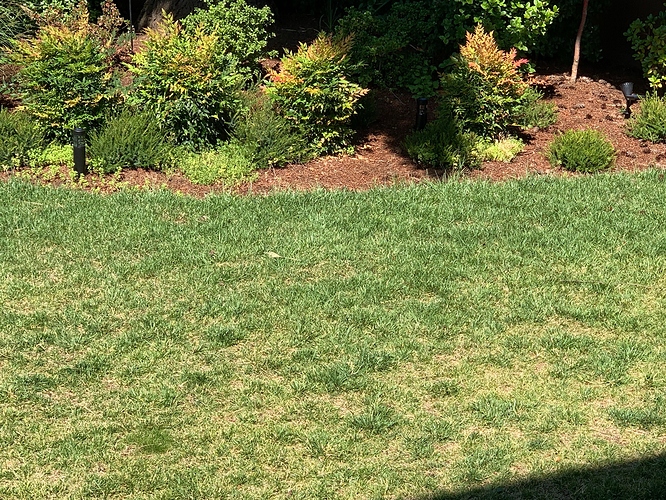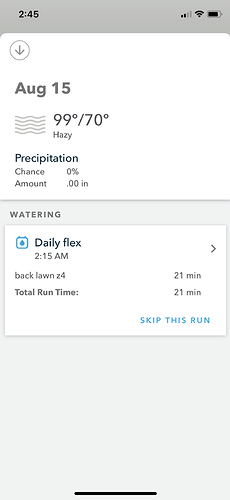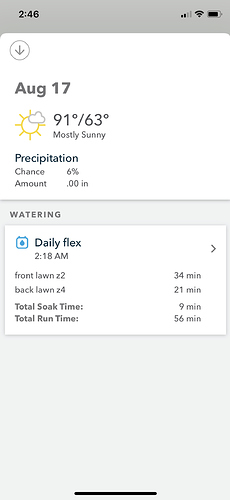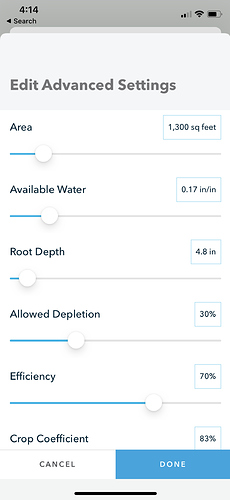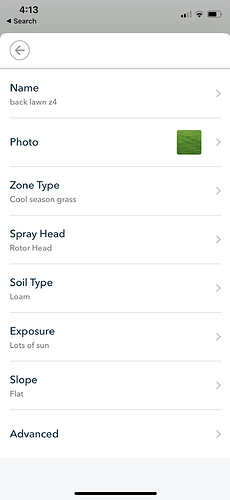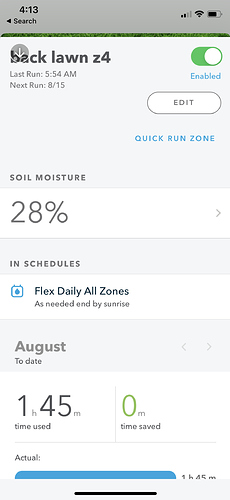Hello,
Just setup the series 3 for our 1 year old new construction house that had an amazing yard, and after a newborn, dog getting surgery who had to use it, things are a bit rougher back there than I hope they can be. We have 4 zones, shrubs in the front and back and 2 lawns. We live in Portland, OR and at first I used the flex daily but the numbers didn’t seem to make sense given the lawn is in a bit of shambles. I put it on flex monthly and hoping for the best. Does anyone have additional tweaks or suggestions to help with the zones? I think it is cool seasonal grass in whatever the most common soil. The shrubs do ok with a few ones that need help. The yard gets a ton of sun in the afternoon. We have a bunch of rotary heads on the lawn, the misty ones in the shrubs. The builders did a great job getting the irrigation in I think. Any other info you guys need to help let me know!
Doesn’t really look that bad. Grass is thin, but its there, just need to thicken it.
You said you setup the Gen3, whats has you puzzled? Do you know what rate you are watering in in/hr? Get a couple measurements of that in your worst areas since thats where you need to focus. Worst case, put some straight walled things like tuna cans, cat food, even 1" tall baking pans out. Run your sprinklers for 30min, then measure the depth of the water and double it, thats your in/hr.
Just a ballpark number but expect 1 in or so of water a week, so knowing your rate, you know a ballpark how long the water sessions should last.
What didn’t make sense about the numbers? With identical settings, I’ve only seen where Flex Daily would give somewhat more water, depending on local temperature/weather, which at the time was warmer than normal. Basically, Flex Daily and Flex Monthly use all the same settings (soil, sprinklers, etc.), except Daily uses Actual weather, while Monthly uses Historic Average weather.
Thanks for the initial replies and suggestion to measure the rate in the worst parts of the lawn.
When I created the first flex daily schedule, which was a big reason I got the system, it said my max watering time for shrubs was over 1 hr - the area of the shrubs are not that 10’x10’ in the front? so it seemed weird during the setup. I read something on here to stay with flex monthly and tweak over time. That’s what I switched to the last few days and had the hunch the lawn needs more water or tweaks, hence my post to the forum. Here are a few screenshots of the flex daily. It seems strange that the biggest zone, the back lawn’s a max time is shorter is than the tiny front lawn - grass patches along a sidewalk and over an hour for the shrubs? It’s going to be 100 degrees and no other zone gets water?
I don’t doubt the knowledge and thought that went into the app and system - for a first time homeowner and new to landscaping, the onboarding and initial setup could use further explanation when the recommendations seem counterintuitive. @rraisley @RPostWVU @franz
Based on my photos and overview, what is your recommendation on how to best leverage the system? Happy to provide more information you would need. I do think the output is about 1” / hr but I’ll retest in the thin patches.
@Jsb The frequency and duration that Rachio recommends for watering is based on the settings for each zone. So in order for people to provide suggestions we need to see the settings for each zone, including the advance settings. Also Rachio has lots of articles and videos that provide detailed information. I found the link below useful. Also how did you determine the the nozzle inches per hour is 1 inch?
Thanks for the additonal requests - makes sense. I lowered the nozzle per hour based on the tuna can experiment but I plan to do it again in the dry spots. I had adjusted it down anticipating it was lower but I want to get a more accurate read on the brown spots. I may have changes the depletion setting to also get more water. Open to any other tweaks.
It’s hard for me to tell too much based on this information. There are pieces, but few direct comparisons. I’d suggest comparing similar (lawn) zones with one another, if you think there’s something wrong with the numbers, that would make it easier to determine. I have a couple comments based on what I’m seeing though:
30% Depletion, especially on Lawns, is too low, I believe. It means it will water only 60% of the normal 50% depletion at one time, reducing water per day, and decreasing time between watering. 50% is a much better figure, I feel.
With Flex Daily, you cannot compare the time for dissimilar zones, like Shrubs and Lawn. Especially with 30% Depletion, Lawn zones will be watered quite often, probably every day or two. Shrub zones, with their deeper roots and water capacity, will take much more water per given area, but will water much less often. That’s the main reason your Shrub zones water so much longer than your Lawn zones. You can usually see this on the Moisture graphs, but when rain is predicted, it’s hard to see. Basically, take the inches of water Rachio will apply at any given time in Inches in the Moisture table, and divide it by the average daily Crop Evapotranspiration. The result is how often the zone will water in days. Do that for the Lawn and Shrub zones, and I think you’ll find very different watering frequencies.
Comparing the Small Front lawn, with high watering time, and Large Rear lawn, with lower watering time, some factor(s) are seriously amiss to get those results. If the soil and grass settings are identical, then the only other factor changing watering time is the Nozzle Inches per Hour, which should be called the Inches of water applied to the zone per Hour, or Application Rate "/hour. If you wonder why any two zones are different, please list all the factors and information, and that will help determine it.
BTW, don’t go changing any calculated Minutes values directly; doing so eliminates the logic in any of the calculations done, and you’ll have no idea where you are.
@Jsb I agree with @rraisley. By lowering the Allowed Depletion you have reduced the amount of water applied to the lawn because it reduces the frequency of watering. And how sure are you of the nozzle inches per hour. If the .85 you set is too high then that will reduce the amount of water applied to the lawn because it will cause Rachio to “think” it has applied enough water when in reality it did not. If you reduce the nozzle inches per hour that will increase the amount of water applied because it will increase the duration of the watering.
I have Hunter PGP heads, some with #4 nozzle and some with #7. I used my water meter to calculate the amount of water applied to each zone. 4 of my zones are set to .65, 2 are set to .8, and 1 is set to 1.0.
Finally, I assume you have ruled out that the brown spots were caused by the dog or insects.
Looks like the lawn could use some fertilizer. I’m assuming the dead spot are where the dog does his/her business but you will notice the edges of those pee spots are nice and green. The center dies from too much nitrate but around the edges seems to be helping green up the grass. Just my 2 cents from afar.
Lowering the Allowed Depletiono reduces the amount of water applied to the lawn AT ONE TIME, not total water applied on average, and as a result, it Increases frequency of watering, not reduces.
@rraisley I am trying to understand what you are saying but am failing. I am not saying that less water is applied each time the schedule is run. I am saying it will take longer to use the moisture between schedule runs if the depletion is set to 30% rather then set to 50%. So if my schedule is watering every 3 days when the depletion is set to 50% won’t it water every 3+ days - say every 4 days or so if the depletion is set to 30% and won’t that mean that over time less water is applied to the lawn?
@rraisley Oh, I think the light bulb just went off. You are saying that it will take more water to replenish the bucket if it is depleted to 30% than if it is depleted to 50%.
Thanks for the educational moment.
No, that’s not the case. With a Flex Daily schedule, the ONLY variable that changes, on average, how much water is applied over time to the lawn is the Crop Coefficient. Except for Nozzle Inches/Hour or Time directly. Crop Coefficient, along with weather conditions (temperature, humidity, etc.) determines the Crop Evapotranspiration value shown on each zone’s graph. For this week, my values per day vary between 0.12" and 0.16", and total 1.02" for the week. On a properly calibrated system, Rachio wants to apply 1.02" during the week. Other factors do NOT change that.
The soil’s Available Water, Root Depth and Allowed Depletion combine to calculate the amount of water Rachio will apply at one time. My zone’s value is 0.17 x 6 x.50 = 0.51" per watering cycle. This results, coincidentally in this case, to watering twice a week (1.02" / 0.51" = 2x per week). Lowering the Allowed Depletion reduces the amount of water applied during one cycle, meaning to apply the same water over the week, Rachio will have to water more often. Substituting 30% in the above, total water at one time = 0.17 x 6 x .30 = 0.306". Meaning it will have to water 1.02 / .306 = 3.33x each week, on average.
That’s one of the things that may not always be explained completely. Depletion, the way it’s used here by Rachio and others, is the water that is REMOVED from the bucket, not the water REMAINING in the bucket. Since 50% is most often used, it makes no difference, they’re the same, but as a result, people can think about it either way.
Using 30% depletion, that is 30% below the filled 100% of the bucket, meaning there is 70% left in the bucket. The amount of water needed to REFILL the bucket will always equal the Depletion.

